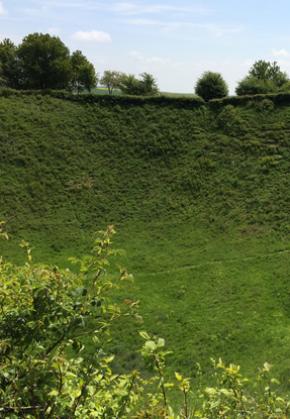 Historial de la Grande Guerre museum in Péronne
© CRT Picardie/AS Flament
Historial de la Grande Guerre museum in Péronne
© CRT Picardie/AS Flament
 Lochnagar Mine Crater
© CRT Picardie
Lochnagar Mine Crater
© CRT Picardie
Don’t miss German veteran Otto Dix’s anti-war works in the Historial.
Dig Deep
Tolkien acknowledged the influence of parts of the war-ravaged landscape on his work – in particular, the Dead Marshes and approaches to the Morannon in The Lord of the Rings, with the faces seen in the water and the mud.
But Fanette Pocentek, who works at the Historial de la Grande Guerre museum in Péronne, is among many experts who believe the Somme had more of an effect on the writer’s work than he always recognised. For instance, Frodo is transformed by his quest just as soldiers are changed by their experiences, and some of his symptoms while carrying and after destroying the Ring resemble those suffered by the shellshocked, including temporary blindness, uncontrollable trembling and anxiety. Meanwhile, the sniffing, hissing, horse-back Ringwraiths of The Lord of the Rings have been likened by some readers to German cavalry soldiers with their gas-masks, and the Ringwraiths’ screams to the sound of flying artillery shells.
Tolkien did acknowledge that Frodo and Sam’s relationship evokes that of an officer and his batman. writing: ‘My Sam Gamgee is indeed a reflexion of the English soldier, of the privates and batmen I knew in the 1914 war, and recognized as so far superior to myself.’ Elsewhere he expressed his ‘deep sympathy and feeling for the “tommy”, especially the plain soldier from the agricultural counties.’
Practical information


